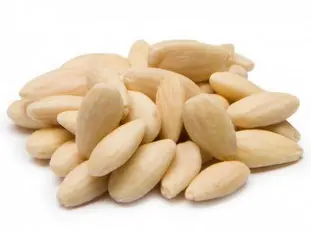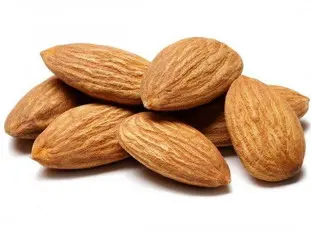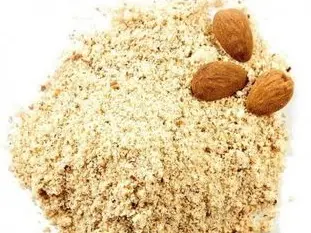The blog of cooking-ez.com
The skin of the almonds

If you like almonds, in their dried fruit version, you must use them quite often in cooking or baking, whether powdered or whole.
It is not obvious, but in fact there is 2 kinds of almonds in the market, wholesale with or without the skin.
It is not obvious, but in fact there is 2 kinds of almonds in the market, wholesale with or without the skin.
18K 15 4.7
Last modified on: February 8th 2020
Keywords for this post:AlmondsDry fruitSkinWhiteGreyThe skin of the almonds
For whole almonds, there are 2 versions in stores: so-called "white" or "blanched" almonds, ie without their brown skin, and "whole" almonds with their skin.
For the almond powder, there is the same powder known as "white almonds" where they are almonds without the skin which are reduced to powder, and the so-called "gray" almond powder where they are the almonds. whole which are crushed.
Then there is a question of aesthetics: the white almond powder is purer, which means that it does not color the preparation in which it is incorporated, which can sometimes be something desired. The most common example is the marzipan, if you want to obtain a smooth paste and of uniform color, it is better to use white almond powder.
So you can see that casually, this skin of almonds which seems quite harmless has consequences on your future pastries, and (a little) on your wallet also, the powder of gray almonds and whole almonds are less expensive than the white ones.
If you have to do it for hazelnuts for example, the best way is to roast them in the oven for 15 minutes at 320°F (160°C), then rub them out of the oven in a tea towel, the skin comes off in the form of a powder that you can dispose.
In summary: For almonds always prefer the version with the skin, much better, unless you need aesthetic purity (marzipan, macaroons), and for other dried fruits, hazelnuts in in particular, it is the opposite, prefer the version without the skin.


For the almond powder, there is the same powder known as "white almonds" where they are almonds without the skin which are reduced to powder, and the so-called "gray" almond powder where they are the almonds. whole which are crushed.


Is there a difference?
Yes, and it is important, first of all the taste: whole almonds, with their skin therefore, have more taste than white almonds, precisely because the skin participates in the taste. It's pretty easy to check, bite into one then the other, and you'll quickly feel the difference. So as a general rule, it is better to use whole almonds or gray powder, your cake or whatever you bake will be better for it.Then there is a question of aesthetics: the white almond powder is purer, which means that it does not color the preparation in which it is incorporated, which can sometimes be something desired. The most common example is the marzipan, if you want to obtain a smooth paste and of uniform color, it is better to use white almond powder.

So you can see that casually, this skin of almonds which seems quite harmless has consequences on your future pastries, and (a little) on your wallet also, the powder of gray almonds and whole almonds are less expensive than the white ones.
Does this apply to all dried fruits?
No, it's often even the opposite, see for example hazelnuts and pistachios, for these 2 it's exactly the opposite, the skin does not add anything at all, it is even quite unpleasant to the taste, and it is strongly advised to withdraw it, or to buy "hulled" ones because for both it is rather painful to withdraw.If you have to do it for hazelnuts for example, the best way is to roast them in the oven for 15 minutes at 320°F (160°C), then rub them out of the oven in a tea towel, the skin comes off in the form of a powder that you can dispose.

In summary: For almonds always prefer the version with the skin, much better, unless you need aesthetic purity (marzipan, macaroons), and for other dried fruits, hazelnuts in in particular, it is the opposite, prefer the version without the skin.
Lasts posts
Wipe meats and fish before cooking
When you want to cook meat or fish, there's a very simple yet very important step to take before you even start: It's to dry, or wipe, each side of the meat or fish, sometimes called "dabbing" or "sponging". But why? And how? Let me explain.1,1125 April 14th 2024
Toss the salad
When you've finished preparing a salad, green or otherwise, it's usually time to add the dressing and toss. It's often said to "toss the salad", which means to season and mix. Is it easy? Not so easy...2,6045 March 8th 2024
Half milk, half cream
In a multitude of recipes, savoury or sweet, milk is used as the main ingredient, or at least as the main liquid ingredient. Milk is used instead of water, for example, because milk contains a proportion of fat, which adds roundness and softness to the recipe. This mellowness is very pleasant on...2,492 February 27th 2024
Cutting soft cheeses
As you may have already noticed, when you have to use a "soft" cheese in a recipe - their exact name is "soft cheese" - such as Camembert, Munster or Mont d'or, it's not easy to make anything other than thick slices.2,6335 February 20th 2024
It's spinning too fast!
When you need to grate or slice vegetables, you generally use an electric machine that does all the work: a food processor, a mixer with a "slicer" extension or similar. Are these machines really suitable? Generally speaking, yes of course, but there's one criterion that often poses a problem,...5,5525 November 12th 2023
Other pages you may also like
What is the difference between bakery and patisserie?
This is a question that you may well have asked yourself and which I will attempt to answer. In France the two trades of "boulangerie" (bakery) and "pâtisserie" (patisserie and confectionery) have always been quite distinct, but where exactly do the boundaries lie? .119K 14.1 February 7th 2017
Candied fruits: don't get ripped off
Do you like candied fruit? You might like to nibble a handful or add it to a recipe, like a classic fruit cake or delicious Italian specialities like panettone or sicilian epiphany pie.53K 24.2 June 21th 2017
The baker always gild twice
I've already told you about gilding, the beaten whole egg that is spread with a brush on anything that needs to brown in the oven: puff pastry, pastries, etc. and that professionals use a lot, I'm going to come back to this to clarify a bit how to do it, and give you a professional tip.26K4.2 June 9th 2019
The so-called "nervous" meats
You've probably heard this before, we're talking about "nervous" meat, or meat with nerves, to describe what is indicated by the blue arrow on the left. This is a piece of beef, and what we call a nerve is not a nerve, it is in fact collagen (chemists sometimes call it a "collagen sink"), a...22K4.5 April 16th 2021
The "pith" of the cauliflower
When using cauliflower in a recipe, there is a lot of preparation work at the beginning: removing the leaves, taking the tops or florets, etc. It's a bit tedious, but in the end you're left with the best of the cauliflower, ready to be used in your recipe.8,2984.9 February 5th 2022
Follow this page
If you are interested in this page, you can "follow" it, by entering your email address here. You will then receive a notification immediately each time the page is modified or a new comment is added. Please note that you will need to confirm this following.
Note: We'll never share your e-mail address with anyone else.
Alternatively: you can subscribe to the mailing list of cooling-ez.com , you will receive a e-mail for each new recipe published on the site.









